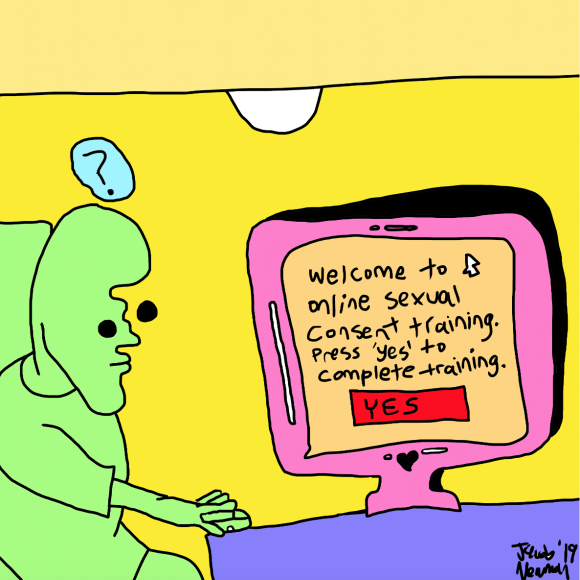
Graphic by Jacob Newman.
Opinions do not necessarily represent CUIndependent.com or any of its sponsors.
It is just four weeks into the fall semester and it seems as if the term “sexual consent” has been forgotten on campus. The words “consent,” “assault” and “no” may bubble up in the minds of college students as they shift their energies from midterms and exams to socializing. But it is unjustified to criticize their failing memory when consent training occurred only once, weeks ago.
The University of Colorado Boulder implemented its consent education program 11 years ago, but only in the last four years did it include anything comprehensive on sexual assault and consent awareness. According to CU’s Office of Institutional Equity Compliance, they “updated in-person bystander programming required for all incoming students that provide[d] more specific skills on recognizing precursors to sexual assault” beginning in summer and fall 2015. In addition to this, “new Sexual Misconduct Policy and OIEC Process and Procedures” were added in July 2015 and a “rise in reports in all categories and increased investigations” began in Fall 2014, which is still in effect today.
You might be wondering why comprehensive revisions to consent education weren’t initiated before 2014. There is no obvious explanation for this and it doesn’t change the statistics for sexual assault at CU, which are exceedingly high. In fact, one of the most recent sexual assaults resulted in an arrest this semester, after a CU student sexually assaulted another student three different times.
There is, however, another culprit standing beside the abuser in every case of sexual assault, one just as guilty as the perpetrator’s immoral self-interest. It is the institution that allows it to survive and in this case, it is CU Boulder.
According to the most recent statistics, 28% of female CU undergraduates report having been sexually assaulted and 6% of males reported experiencing sexual assault on campus. Twentyone percent of LGBTQ undergraduates reported being sexually assaulted and 90% of all college sexual assaults were found to have been with someone the victim already knew.
Why does this problem of high sexual assault rates persist at a university with as many financial resources as CU? CU Boulder ranked 85th out of the most wealthy colleges in the country in 2018, with a current endowment over $1.6 billion. The Office for Victim’s Assistance (OVA) and the Office of Institutional Equity and Compliance (OIEC) receives some monetary benefits to help with their programming. Yet after freshman year, consent education disappears from student curriculum, leaving them languishing to remember proper sexual etiquette. You might be wondering: What were they taught in the first place?
CU uses a combination of an online module and in-person bystander training. The school refers vaguely to these programs as ones that teach “the definitions of prohibited behavior and affirmative consent” as well as “where to get help and report it (if they choose to do so).” They also say that “education is already provided in many forms, but we need to expand that to reach a wider audience.” This demand is not addressed further or supported empirically in their statements about current consent education.
The online experience is a four-page summary of university policies on proper conduct and definitions of consent including a brief description on incapacitation. Access to this online education ends after the first semester.
Bystander training is a one-time, in-person, hour-long session focusing on “good Samaritan” behavior. From my experience, these scenarios were unrealistic, simplified and only barely touched on consent. Bromides traditionally associated with consent were rehearsed as if students were supposed to completely understand their depth and potential impact. Common phrases were “no means no” and “stop every 5 seconds to check in with your partner.”
This is comparable to learning mathematical formulas in a sociology classroom. Not only that, but it ends before the first day of college even begins.
Many sexual consent experts advocate for a different approach. Monica Rivera, director of the Women and Gender Advocacy Center at Colorado State University, wrote in a recent article that consent education should include body literacy, information on verbal and non-verbal cues, power and identity dynamics, bodily sensations, disentanglement of “consent” from “sex” and over a decade-long informational timeframe; in other words, a continuous education. CU does not promote any of these strategies sufficiently through their consent training.
Sexual violations should be dealt with in a socially restorative fashion, not simply at a legal or institutional level. It is vital that sexual consent training not only be more comprehensive, but continuous on campus. More than one in-person training session must occur per school year. If anything, training must be renewed each year a student attends CU.
Imperative information such as this could remold the current sociosexual atmosphere on campus. At a party, a sophomore jokingly told me to not say the words “sexual assault” to him as they are “legally life-threatening to a cis[gender], white male on campus.” His pleas did not stop me. Those words are one of my only defense mechanisms against unwanted sexual advances as a female student on CU’s campus.
Even more importantly, the deficits in consent education — brought to CU’s attention for years now — seem to be ignored. This problem wasn’t born recently or newly uncovered in the backrooms of the OVA. It’s time that CU shows it takes sexual assault and awareness training seriously. CU should begin utilizing the high-level educational resources it not only stands for but has ready access to when it comes to teaching students about consent.
Informed student dialogue around consent must finally begin on campus. A thoughtful and effective consent training is imperative for student safety. Educating and keeping students safe should be an obligation for CU, not an option.
Contact CU Independent Staff Writer Vayle LaFehr at vayle.lafehr@colorado.edu.
